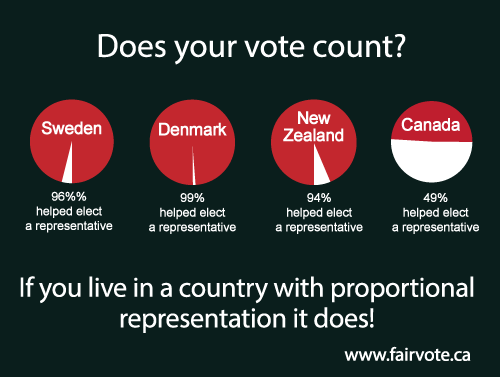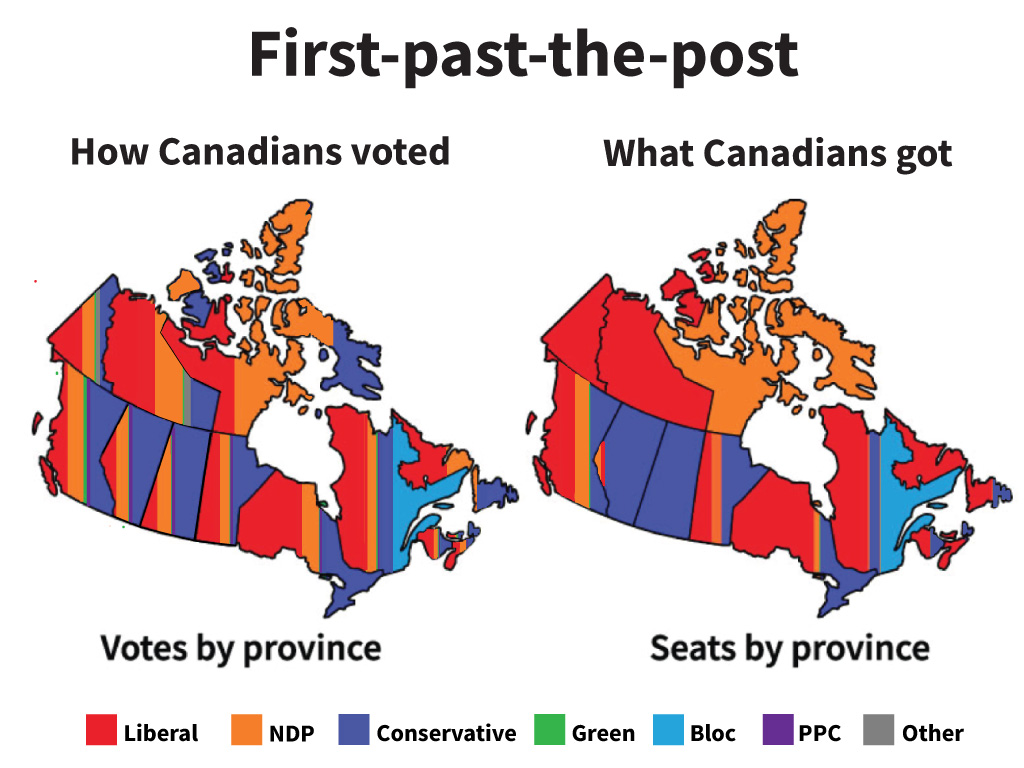Sometimes opponents claim that proportional representation is “bad for rural voters. Cities will have too much power, they claim. Or rural seats will “disappear”.
These misleading attempts to pit rural voters against urban ones appears to be a strategy of opponents of fair voting.
Let’s set the record straight: proportional representation is good for all voters, rural and urban.
No matter where you live, or who you vote for, you deserve to help elect an MP who shares your values. That’s the basic principle of proportional representation.
All models of proportional representation for Canada maintain strong local representation as a top priority.
a
Problems with winner-take-all voting for for rural and urban voters
a
First-past-the-post shuts voters out. Safe seats make voting feel futile.
In Alberta, Bow River has been a safe Conservative seat since 1958. Who represents those who didn’t vote Conservative?
Vancouver-Kingsway has been held by the NDP in every election except one since 1956. If you vote Liberal, Conservative or Green in Vancouver-Kingsway, who represents you?
As many people have observed, first-past-the-post can create a sense of futility for many voters. For many voters in safe seats, their votes are physically counted, but they never actually count.
Contrast this with the 95% of voters in Sweden and New Zealand who were able to cast votes that helped elect representatives to their legislatures. Proportional representation will give every voter – rural and urban – a voice.

First-past-the-post masks the true political diversity of Canada, including in rural areas.
As Colin Walmsley notes in an op-ed on CBC, “Blame first past the post for Canada’s growing rural-urban divide”:
Though you wouldn’t know it by looking at a map of our election results, we aren’t quite as divided as our land-centric electoral system would make it seem. Millions of rural Canadians regularly vote for progressive parties, just like millions of urban Canadians vote for conservative ones.
As this map below of the 2019 federal election shows, considerable diversity in voter preferences exists in every region of Canada, both rural and urban. Winner-take-all election results mask that diversity.

In the 2019 federal election, every seat in the Greater Toronto area went Liberal – despite 45% of voters choosing parties other than the Liberals.
In the same election, every seat in Saskatchewan went Conservative, despite about ⅓ of voters choosing parties other than the Conservatives.
No matter where you live in Canada, rural or urban, you are surrounded by neighbours who voted differently.
Winner-take-all voting masks these differences, leading to single party sweeps of entire regions – rural or urban.
This is where proportional representation comes in.
Proportional representation doesn’t shift the balance of seats between urban and rural voters at all.
But it does ensure that political preferences in each region are accurately reflected – that almost all voters have representation that aligns with their values, no matter where they live.
a
Benefits of proportional representation for rural voters
- All models of proportional representation have strong local and regional representation. Voters will retain their local representatives and no seats will move to the cities. In fact, rural ridings will be able to amplify their voices because every vote will actually count! Proportional representation will be tailored to the geography of each region, since no one size fits all, and riding boundaries will continue to be determined by an independent boundaries commission which considers community of interest, community of identity, historical patterns, and the need to keep the geographic size of ridings manageable.
- With PR, every voter is much more likely to have an MP responsive to the concerns of the voter and his/her community, whether due to party affiliation, roots in the community, or simply the MP’s willingness or ability to work to find solutions. Every voter will have a choice of MPs to go to, including an MP the voter helped elect.
a - Most regions will have MPs who are part of the government, rather than regions being shut out.In the past, we have all witnessed cheques being written for projects in ridings with government MPs, while ridings with opposition MPs are mostly ignored. With first-past-the-post, one party can sweep all the seats in a region, but if the MPs are all in the opposition, voters in those ridings fear being ignored by the governing party. The 2019 election provided an extreme of this dynamic, leaving voters in Alberta and Saskatchewan with no voice in government, exacerbating “western alienation.”
With proportional representation, every local area or region will have MPs from more than one party. Competition and collaboration between MP’s is likely to mean more responsiveness to voters’ needs.
a - Teamwork between MPs in a riding promotes good regional decision making, problem solving and governance for the benefit of everyone in the region. Proportional representation makes almost every vote count, no matter where you live. It means 30% of the vote will equal 30% of the seats – in your local region. Collectively, this produces fair overall results in legislatures, leading to cooperative governments representing a real majority of voters.
